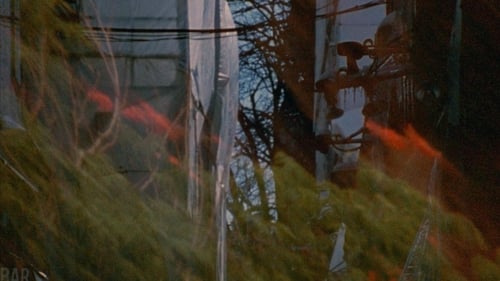The Riddle of Lumen (1972)
Género :
Tiempo de ejecución : 14M
Director : Stan Brakhage
Sinopsis
“The Riddle of Lumen” presents an evenly paced sequence of images, which seem to follow an elusive logic. As in “Zorns Lemma” the viewer is called upon to recognize or invent a principle of association linking each shot with its predecessor. However, here the connection is nonverbal. A similarity, or an antithesis, of color, shape, saturation, movement, composition, or depth links one shot to another. A telling negative moment occurs in the film when we see a child studying a didactic reader in which simply represented objects are coupled with their monosyllabic names in alphabetical order. –P. Adams Sitney

An experimental film by Stan Brakhage. Frenetic editing and hand-painted film accompany scenes of dogs and raccoons, snakes and mice.

A short film by Stan Brakhage.

“Freud established that jokes were structurally akin to dreams in their use of condensation, displacement, representation by opposites, punning and ‘nonsense’. All of these strategies are much in evidence in (Land’s) marvelously duplicitous ON THE MARRIAGE BROKER JOKE… [...] so clever and original a filmmaker as to make most others – not to mention his critics – seem flat-footed by comparison. ON THE MARRIAGE BROKER JOKE harks back to Bunuel’s early work. Not only is it structured like a dream and filled with sexual imagery, but like Un Chien Andalou, it smacks of being an insider’s joke played upon the avant-garde. Where Bunuel used the insights of psychoanalysis to satirize Christianity, Land– with an almost equal perversity – reverses the process and uses Christianity to send up Freud.” – J. Hoberman, American Film

A short film by Stan Brakhage featuring music by Rick Corrigan.

A short film by Stan Brakhage.

This meditation takes its visual imperatives from the occasion of Mesa Verde.

The final Duplicity film does seem at resolve with the term. All previous visual manifestations have been extended to their limits, through four-roll superimpositions. Obvious costumes and masks. Drama as an ultimate bid for truth, and totemic recognition of human and animal life-on-earth dominate all the evasions a duplicity otherwise affords.

A combination of hand-painting and photography.

Peripheral envisionment of daily life as the mind has it - i.e., a terrifying ecstasy of (hand-painted) synapting nerve ends back-firing from thought's grip of life.

In this haunting but lyrical meditation on war, Brakhage intercuts 8-mm footage of Colorado with imagery from WWII newsreels. He responds to the violence and nightmare of war by painting directly on the filmstrip.

Says Fred Camper of the film: "Invited to Riverside, California, Brakhage, under the mistaken impression that it was a desert, was planning a desert movie when he arrived to discover an unattractive suburban landscape. So he decided to make, and shoot, a desert on his motel room table".

This film by Stan Brakhage investigates the process of memory and thought by melting a series of images and a field of color. The positive-negative flickering graphs a sort of shutter-window all over the matter of the vision. Jittery flocks of space are interweaving as pieces of language in a scant illumination, whereas the process of thought is sheared in fuzzy transience.


This is a film inspired by Gertrude Stein's "Stanzas In Meditation", in which the filmmaker has edited a meditative series of images of landscapes and human symbolism "indicative of that field-of-consciousness within which humanity survives thoughtfully." It is a film "as in a dream," this first film in a proposed series of such being composed of images shot in the New England states and Eastern Canada. It begins with an antique photograph of a baby and ends with a child loose on the landscape, interweaving images of Niagara Falls with a variety of New England and Eastern Canadian scenes, antique photographs, windows, old farms and cityscapes, as it moves from deep winter, through glare ice, to thaw.

No information available regarding the film's director. Just under 10 minutes of over an hour's footage survive.

The second part: Brakhage’s layering of images spends less time with images of war, and begins filtering in scenes of Vienna and his home in Colorado. He sets up a comparison between “Kubelka’s Vienna” and his own.

A meadow, a lake, the silhouette of a hill, trees. 21 days of the same view in Saarland. 21 days with five different cut-outs in a mask before the camera, which finally reveals a complete panorama. The landscape changes with the advancing seasons and becomes slowly delirious in its technical alienation.

This film, photographed in London, is an exploration into the depths of unconscious reactions.

Although best known for his photography, Steven Arnold also wrote, designed, and directed several groundbreaking visionary films, The Liberation of Mannique Mechanique being the first. Stuart Comer of the Tate Modern (London) said of Mannique: “a macabre, decadent work presenting mannequins and models that travel through strange universes toward possible self-discovery.” Brooklyn-based artist and writer Kate Wadkins in a recent online article observed: “Arnold’s films are dream-like visions of androgynous beings. Their narratives are modern-day fairy tales and reveries about gender — all through the lens of an acid trip.”

The "star", as it is singular, is the sun; and it is metaphored, at the beginning of this film, by the projector anyone uses to show forth. Then the imaginary sun begins its course throughout whatever darkened room this film is seen within. At "high noon" (of the narrative) it can be imagined as if in back of the screen, and then to shift its imagined light-source gradually back thru aftertones and imaginings of the "stars" of the film till it achieves a one-to-one relationship with the moon again. This "sun" of the mind's eye of every viewer does not necessarily correspond with the off-screen "pictured sun" of the film; but anyone who plays this game of illumination will surely see the film in its most completely conscious light.




